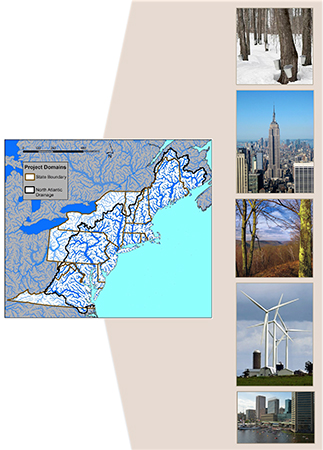
The Northeast Regional Earth System Model
Central Hypothesis
There are regionally significant consequences of human decisions on the environmental systems of the Northeast, expressed through the action of both natural and engineered human systems that dictate the region's biogeophysical state, ecosystem services, energy and economic output.
The Northeast has a rich history of strategic environmental transformations: from deforestation and land clearing to industrialization and urbanization to post-industrial, mega-city growth. The closely woven human-environment system of the region will continue and arguably be more difficult to manage in the 21st Century due to the impacts of global climate change. In the context of climate change and long term ecosystem response times, environmental management decisions made today will reverberate through the remainder of this century.
Since atmosphere, land and aquatic ecosystems are closely linked through water, energy and biogeochemical cycles, changes to any one of these systems may lead to unintended feedbacks and consequences. Yet, scientific tools to assist decision- makers in understanding human-environment systems over the regional domain and decadal timescales are currently limited. We are currently developing a Northeast Regional Earth System Model to better understand the interaction between our infrastructure, land, atmosphere and freshwater systems and to provide insight on the implications of environmental management decisions.

The Northeast Modeling Domain. Images (from top to bottom): Maple Tapping, Lake George, New York; Empire State Building, New York (courtesy: Jiuguang Wang, http://jw.nebulis.org); Tioga State Forest, Pennsylvania (courtesy: Nicholas Tonelli, http://www.flickr.com/photos/nicholas_t/); Maple Ridge Wind Farm, New York; Baltimore Inner Harbor, Maryland.

